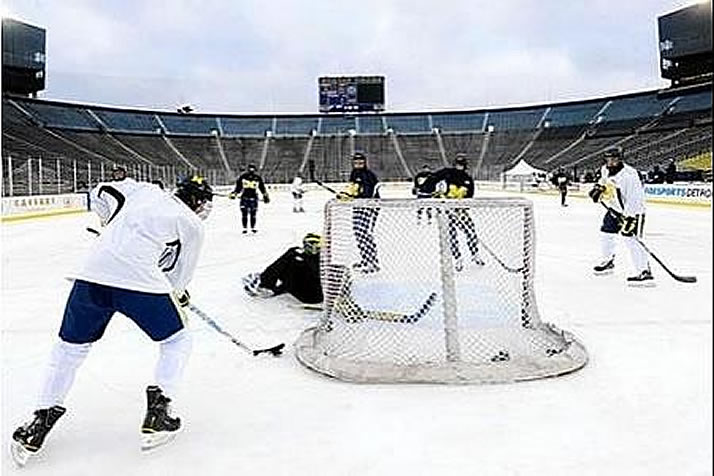Thursday, December 9, 2010
How Far Can College Hockey Go?
As Michigan Readies for Michigan State, and 113,000 fans, the Sport’s ‘Niche’ Status Is Under Review

By NICOLE AUERBACH – The Wall Street Journal
Ann Arbor, Mich. – This Saturday, Michigan will host Michigan State in an outdoor hockey game at its football stadium before an anticipated crowd of 113,000 people. For two hours, “The Big Chill,” as the event is being called, will shove college hockey into an unusual spot: the center of the national sports discussion.
To optimists, there’s some evidence this game could be college hockey’s apotheosis: the moment it finally muscles up to the same table as its bigger siblings, basketball and football.
The Michigan athletic department sold nearly 80,000 tickets for the game on the first day of sales and the event has been essentially sold out since October. Thanks to the enormity of the crowd?it will shatter the attendance record for the number of people watching a hockey game by nearly 40,000?Michigan expects its hockey program to bring in more ticket revenue than basketball this season by a margin of more than $1 million.
Ronnie Mason, an employee of Ice Rink Events of Houston, shovels excess snow off the ice rink at Michigan Stadium on Dec. 1 to prepare it for Saturday’s ‘Big Chill’ hockey game between Michigan and Michigan State.
This unprecedented game comes at a time when the sport is already expanding beyond its traditional boundaries. Paul Kelly, the president of College Hockey Inc., the year-old marketing arm of NCAA hockey, estimated that up to five more schools may upgrade their club-hockey teams to varsity status in the next few years.
Penn State will become the nation’s 59th Division I hockey school when its team goes varsity in the 2012-13 season. The school is also building an arena that will cost as much as $80 million. New arenas are on the way at Notre Dame and the Rochester Institute of Technology and Wisconsin is building a new practice facility.
Joe Bertagna, the commissioner of Hockey East, pointed to signs the sport’s appeal is crossing geographic boundaries. The percentage of college hockey players who hail from non-traditional hockey-playing areas has risen to 10.6% this season from just 3.8% nine years ago.
Now the question is: How far can college hockey go?
Penn State’s ascension to Division I has led to speculation that the Big Ten will form its own hockey conference, since it will have the requisite six teams. (Currently, the Big Ten’s five hockey schools are split up in two hockey-only conferences, the Central Collegiate Hockey Association and Western Collegiate Hockey Association.)
Other cold-weather schools with successful club programs, like Illinois, could also make the move to Division I. An Illinois spokesman said the school has no plans to consider adding hockey as a varsity program.
And then there’s TV: The Big Ten Network, the conference’s lucrative three-year-old sports channel, is a natural outlet that can carry games both regionally and nationally. The network is broadcasting nine hockey games this season. “We’d be interested in doing more,” said spokeswoman Elizabeth Conlisk. “It certainly has quite a bit of appeal in this part of the country.”
Big Ten schools, and Michigan in particular, demonstrate the sport’s potential. The Wolverines draw near-sellout crowds at every home game at Yost Ice Arena, which holds 6,637 fans. And hockey tickets can be $30 cheaper than football tickets. Michigan athletic director David Brandon calls hockey the “best ticket in town.”
Hockey converts say the size of the venues, the proximity to the action and the dedication of the fans?not to mention the colorful (and sometime obscene) chants they aim at opposing goalies make the atmosphere more appealing. “It’s not people who vaguely associate with Michigan hockey,” said David Schwartz, a junior. “The people who go to the games love the team and have an intimate knowledge of the sport.”
Michigan hockey coach Red Berenson called the small but fervent group of hockey fans “friends” of hockey.
Still, those close to college hockey understand that the sport hasn’t come close to its ceiling?and isn’t likely to get there overnight.
Hockey has historically been a Northern sport with the highest participation in states like Minnesota, Michigan, and Massachusetts. The 58 Division I hockey programs are fewer than half the number of top-tier college football teams (120) and is light years behind the 347 programs in college basketball. The hockey season, which runs from October into April, coincides with both basketball and football.
The size of the Big Chill crowd isn’t purely a testament to hockey. The novelty of the event and the rivalry between the two schools played a role, as did Michigan’s decision to hold down prices.
Michigan State’s hockey team is popular on campus, but has lately been competing with the school’s highly ranked football and basketball teams, both of which are regularly on national television. The Spartans had a 323-game streak of consecutive home hockey sellouts from 1985 to 2004, but have seen hockey attendance dip since their 2007 national championship season.
Michigan hockey players play a pick-up game on Monday as they test out the ice for the first time.
The sport has also sabotaged itself in small ways. While the NCAA hockey tournament?with its single-elimination format and chaotic, unpredictable nature?is one of the most entertaining spectacles in college sports, its attendance in regional rounds can be weak. The problem: most games are held in neutral sites. Last season, when Miami (Ohio) beat Michigan in double overtime in Fort Wayne, Ind., for a spot in the Frozen Four, just 3,204 fans showed up.
“You’ll see growth” in hockey, said former Michigan athletic director Bill Martin, “but it won’t be exponential.”
Whether or not the Big Chill serves as a seismic event in college sports, there’s no question the event is creating excitement. The throwback uniforms Michigan players will wear Saturday have been hot sellers on campus. “It’s a great opportunity for new fans to come and watch that wouldn’t normally,” Michigan State hockey coach Rick Comley said. “It creates a unique opportunity to sit outside in the elements and watch the game as it was invented.”
-Darren Everson contributed to this article
